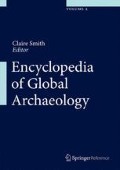Access this chapter
Tax calculation will be finalised at checkout
Purchases are for personal use only
References
Bentley, R. A. 2006. Strontium isotopes from the earth to the archaeological skeleton: a review. Journal of Archaeological Method and Theory 13(3): 135-87.
Gale, N.H., A.P. Woodhead, Z.A. Stos-Gale, A. Walder & I. Bowen. 1999. Natural variations detected in the isotopic composition of copper: possible applications to archaeology and geochemistry. International Journal of Mass Spectrometry 184(1): 1-9.
Grün, R., M. Aubert, R. Joannes-Boyau & M.H. Moncel. 2008. High resolution analysis of uranium and thorium concentration as well as U-series isotope distributions in a Neanderthal tooth from Payre (Ardeche, France) using laser ablation ICP-MS. Geochimica et Cosmochimica Acta 72(21): 5278-90.
Grun, R., H.P. Schwarcz & S. Zymela. 1987. Electron-spin-resonance dating of tooth enamel. Canadian Journal of Earth Sciences 24(5): 1022-37.
Hedges, R.E.M. & L.M. Reynard. 2007. Nitrogen isotopes and the trophic level of humans in archaeology. Journal of Archaeological Science 34(8): 1240-51.
Jaouen, K., V. Balter, E. Herrscher, A. Lamboux, P. Telouk & F. Albarède. 2012. Fe and Cu stable isotopes in archeological human bones and their relationship to sex. American Journal of Physical Anthropology 148(3): 334-40.
Knudson, K.J., H.M. Williams, J.E. Buikstra, P.D. Tomczak G.W. Gordon & A.D. Anbar. 2010. Introducing δ88/86Sr analysis in archaeology: a demonstration of the utility of strontium isotope fractionation in paleodietary studies. Journal of Archaeological Science 37: 2352-64.
Lee-Thorp, J. 2002. Two decades of progress towards understanding fossilization processes and isotopic signals in calcified tissue minerals. Archaeometry 44(3): 435-46.
Leyden, J.J., L.I. Wassenaar, K.A. Hobson & E.G. Walker. 2006. Stable hydrogen isotopes of bison bone collagen as a proxy for Holocene climate on the Northern Great Plains. Palaeogeography, Palaeoclimatology, Palaeoecology 239(1–2): 87-99.
Privat, K.L., T.C. O'Connell & R.E.M. Hedges. 2007. The distinction between freshwater- and terrestrial-based diets: methodological concerns and archaeological applications of sulphur stable isotope analysis. Journal of Archaeological Science 34(8): 1197-204.
Reynard, L.M. & R.E.M. Hedges. 2008. Stable hydrogen isotopes of bone collagen in palaeodietary and palaeoenvironmental reconstruction. Journal of Archaeological Science 35: 1934-42.
Reynard, L.M., G.M. Henderson & R.E.M. Hedges. 2010. Calcium isotope ratios in animal and human bone. Geochimica et Cosmochimica Acta 74(13): 3735-50.
Richards, M.P. & E. Trinkaus. 2009. Isotopic evidence for the diets of European Neanderthals and early modern humans. Proceedings of the National Academy of Science 106: 16034-9.
Richards, M.P., B.T. Fuller, M. Sponheimer, T. Robinson & L. Ayliffe. 2003. Sulphur isotopes in palaeodietary studies: a review and results from a controlled feeding experiment. International Journal of Osteoarchaeology 13(1-2): 37-45.
Schurr, M. R. 1998. Using stable nitrogen-isotopes to study weaning behavior in past populations. World Archaeology 30(2): 327-42.
Sponheimer, M. & J. Lee-Thorp. 1999. Oxygen isotopes in enamel carbonate and their ecological significance. Journal of Archaeological Science 26: 723-8.
Stos-Gale, Z.A. & N.H. Gale. 2009. Metal provenancing using isotopes and the Oxford archaeological lead isotope database (OXALID). Archaeological and Anthropological Sciences 1: 195-213.
Further Reading
Dickin, A.P. 2005. Radiogenic isotope geology. Cambridge: Cambridge University Press.
Pollard, M., C. Batt, B. Stern & S.M.M. Young. 2007. Analytical chemistry in archaeology. Cambridge: Cambridge University Press.
Author information
Authors and Affiliations
Corresponding author
Editor information
Editors and Affiliations
Rights and permissions
Copyright information
© 2014 Springer Science+Business Media New York
About this entry
Cite this entry
Moffat, I. (2014). Isotope Geochemistry in Archaeology. In: Smith, C. (eds) Encyclopedia of Global Archaeology. Springer, New York, NY. https://doi.org/10.1007/978-1-4419-0465-2_1712
Download citation
DOI: https://doi.org/10.1007/978-1-4419-0465-2_1712
Publisher Name: Springer, New York, NY
Print ISBN: 978-1-4419-0426-3
Online ISBN: 978-1-4419-0465-2
eBook Packages: Humanities, Social Sciences and Law

